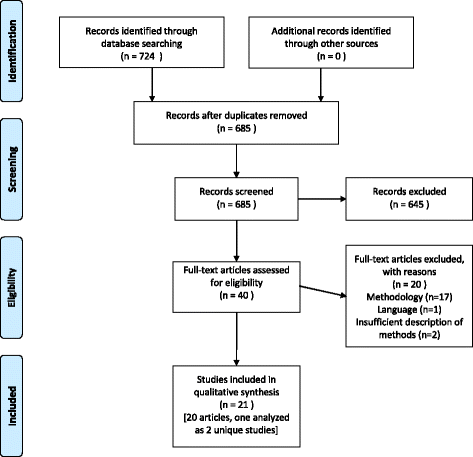Information sources for obesity prevention policy research: a review of systematic reviews
- PMID: 28789703
- PMCID: PMC5549286
- DOI: 10.1186/s13643-017-0543-2
Information sources for obesity prevention policy research: a review of systematic reviews
Abstract
Background: Systematic identification of evidence in health policy can be time-consuming and challenging. This study examines three questions pertaining to systematic reviews on obesity prevention policy, in order to identify the most efficient search methods: (1) What percentage of the primary studies selected for inclusion in the reviews originated in scholarly as opposed to gray literature? (2) How much of the primary scholarly literature in this topic area is indexed in PubMed/MEDLINE? (3) Which databases index the greatest number of primary studies not indexed in PubMed, and are these databases searched consistently across systematic reviews?
Methods: We identified systematic reviews on obesity prevention policy and explored their search methods and citations. We determined the percentage of scholarly vs. gray literature cited, the most frequently cited journals, and whether each primary study was indexed in PubMed. We searched 21 databases for all primary study articles not indexed in PubMed to determine which database(s) indexed the highest number of these relevant articles.
Results: In total, 21 systematic reviews were identified. Ten of the 21 systematic reviews reported searching gray literature, and 12 reviews ultimately included gray literature in their analyses. Scholarly articles accounted for 577 of the 649 total primary study papers. Of these, 495 (76%) were indexed in PubMed. Google Scholar retrieved the highest number of the remaining 82 non-PubMed scholarly articles, followed by Scopus and EconLit. The Journal of the American Dietetic Association was the most-cited journal.
Conclusions: Researchers can maximize search efficiency by searching a small yet targeted selection of both scholarly and gray literature resources. A highly sensitive search of PubMed and those databases that index the greatest number of relevant articles not indexed in PubMed, namely multidisciplinary and economics databases, could save considerable time and effort. When combined with a gray literature search and additional search methods, including cited reference searching and consulting with experts, this approach could help maintain broad retrieval of relevant studies while improving search efficiency. Findings also have implications for designing specialized databases for public health research.
Keywords: Bibliographic databases; Health policy; Information storage and retrieval; Obesity prevention; Review literature as topic; Systematic review methodology.
Conflict of interest statement
Authors’ information
RH is an Assistant Professor and Information Services Librarian at the Library of the Health Sciences at the University of Illinois at Chicago (UIC). She is the liaison librarian to the School of Public Health and works directly with faculty, graduate students, and other key researchers in public health and health policy. Her research seeks to improve information access for researchers in the health sciences, particularly in her focus area of public health. SY is a PhD candidate in Health Policy and Administration and a predoctoral research fellow through the Cancer Education and Career Development Program at UIC’s Institute for Health Research and Policy. Her research focuses on increasing population health and reducing health disparities through state and federal policy.
Ethics approval and consent to participate
Not applicable.
Consent for publication
Not applicable.
Competing interests
The authors declare that they have no competing interests.
Publisher’s Note
Springer Nature remains neutral with regard to jurisdictional claims in published maps and institutional affiliations.
Similar articles
-
A comparison of the performance of seven key bibliographic databases in identifying all relevant systematic reviews of interventions for hypertension.Syst Rev. 2016 Feb 9;5:27. doi: 10.1186/s13643-016-0197-5. Syst Rev. 2016. PMID: 26862061 Free PMC article.
-
Supplementary strategies identified additional eligible studies in qualitative systematic reviews.J Clin Epidemiol. 2023 Jul;159:85-91. doi: 10.1016/j.jclinepi.2023.04.017. Epub 2023 May 17. J Clin Epidemiol. 2023. PMID: 37201687
-
A Critical Review of Search Strategies Used in Recent Systematic Reviews Published in Selected Prosthodontic and Implant-Related Journals: Are Systematic Reviews Actually Systematic?Int J Prosthodont. 2017 Jan/Feb;30(1):13-21. doi: 10.11607/ijp.5193. Int J Prosthodont. 2017. PMID: 28085971 Review.
-
Searching for qualitative health research required several databases and alternative search strategies: a study of coverage in bibliographic databases.J Clin Epidemiol. 2019 Oct;114:118-124. doi: 10.1016/j.jclinepi.2019.06.013. Epub 2019 Jun 25. J Clin Epidemiol. 2019. PMID: 31251982
-
Cochrane systematic reviews in acupuncture: methodological diversity in database searching.J Altern Complement Med. 2005 Aug;11(4):719-22. doi: 10.1089/acm.2005.11.719. J Altern Complement Med. 2005. PMID: 16131298 Review.
Cited by
-
Scientific Literature Database Coverage of Randomized Clinical Trials for Central Serous Chorioretinopathy.J Pers Med. 2023 Jun 12;13(6):983. doi: 10.3390/jpm13060983. J Pers Med. 2023. PMID: 37373972 Free PMC article.
-
Literature searching methods or guidance and their application to public health topics: A narrative review.Health Info Libr J. 2022 Mar;39(1):6-21. doi: 10.1111/hir.12414. Epub 2021 Dec 1. Health Info Libr J. 2022. PMID: 34850535 Free PMC article. Review.
-
Efficient searching for NICE public health guidelines: Would using fewer sources still find the evidence?Res Synth Methods. 2022 Nov;13(6):760-789. doi: 10.1002/jrsm.1577. Epub 2022 Jun 23. Res Synth Methods. 2022. PMID: 35657294 Free PMC article.
References
-
- Chriqui JF, Young SK. Public health policy analysis and evaluation. In: Eyler AA, Chriqui JF, Moreland-Russell S, Brownson RC, editors. Prevention, policy, and public health. New York: Oxford University Press; 2016. pp. 67–92.
-
- Ogden CL, Caroll MD, Lawman HG, Fryar CD, Kruszon-Moran D, Kit BK, Flegal KM, Centers for Disease Control and Prevention (CDC) Trends in obesity prevalence among children and adolescents in the United States, 1988–1994 through 2013-2014. JAMA. 2016;315(21):2292–2299. doi: 10.1001/jama.2016.6361. - DOI - PMC - PubMed
-
- May AL, Freedman D, Sherry B, Blanck HM. Obesity—United States, 1999–2010. MMWR Suppl. 2013;62(3):120–128. - PubMed
Publication types
MeSH terms
Grants and funding
LinkOut - more resources
Full Text Sources
Other Literature Sources
Medical


